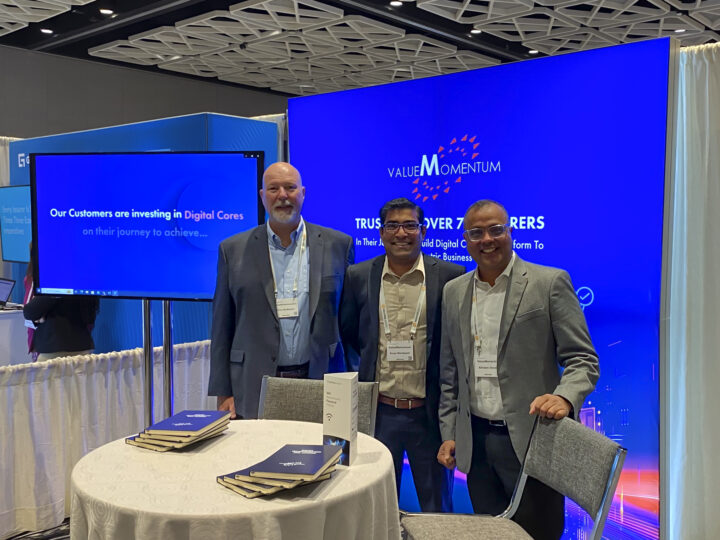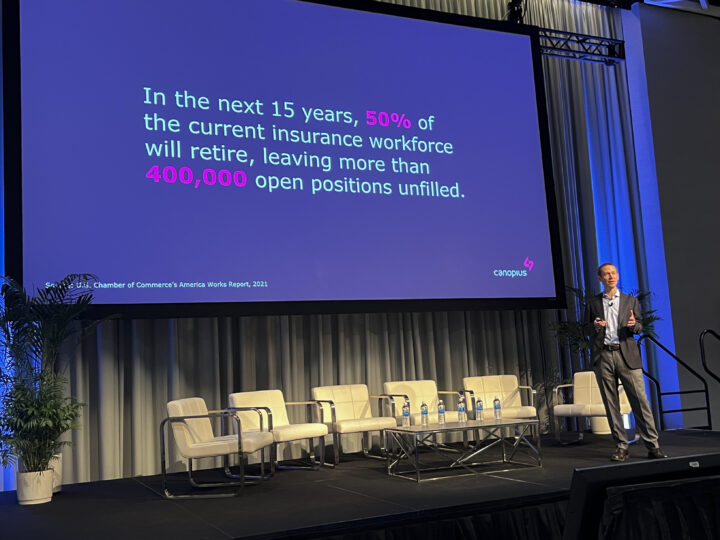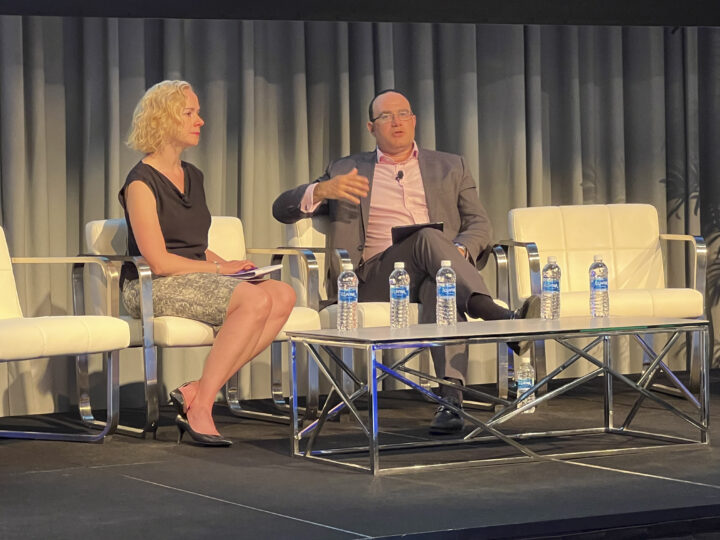At Reuters Events’ The Future of Insurance USA 2023 in Chicago, insurance execs gathered to hear business and tech leaders expound on where insurance innovation is going and how to get there themselves. Like previous years, themes in digital transformation of insurance have remained consistent:
- Insurance is a people business
- Customer experience is critical to success
- Data defines the path to the future
- Legacy systems and thinking continue to be obstacles
- IT talent and culture are critical to long-term success
The only difference between then and now is that the technology–and its cloud-based foundation, with its scalability and openness—is mature enough to support the pace of change we are seeing in other industries. Which is important, because the pace of change is only increasing.
Across the two days of speaking sessions, discussions, and conversations, it is clear to all in attendance that the industry is standing on the brink of massive transformation, and data, customer experience, and IT talent are critical to successful innovations.
Here are some insights from insurance leaders on how to move the needle forward in these areas to achieve business success now and into the future.

Overcoming Constant Change to Drive the Future of Insurance
Takeaways from the introductory discussions with Erie Insurance’s CEO Tim NeCastro and Partha Srinivasa, EVP and CIO, centered on the need for a strategic approach to fostering practical innovation, integrating new and old technologies, focusing on the “segmentation of innovation efforts,” and forging valuable partnerships—all in the service of delivering exceptional customer experiences.
“It starts and ends with people,” NeCastro said. “Our secret weapon is the relationship we’ve developed with independent agents over the past 100 years.”
Embracing technology to enhance the customer experience is paramount, they agreed. By leveraging digital channels and combining them with an agent-centric model, insurers can provide customers with meaningful self-service tools, expedite claims with greater transparency and automation, and deliver real-time assistance. The goal is a harmonious blend of human expertise and technology to create a personalized and efficient customer journey. And it’s soon to become the norm.
A practical approach to innovation is essential to driving meaningful advancements. Instead of chasing every new trend, Erie is focusing on solving specific industry problems. By fostering a culture of collaboration and experimentation, they are uncovering innovative solutions that directly address the evolving needs of customers. This targeted approach to innovation can set insurers apart in the market and generate tangible outcomes.
Embracing AI for Success with Emerging Risks
“To say that insurers are at an inflection point and in the middle of a perfect storm would be gross understatement, and probably preaching to the choir,” said Fractal Analytics’ Sankar SN Narayanan, Chief Practice Officer, Technology and Insurance. In his presentation “Embracing the Next Revolution,” he explored the convergence of emerging risks, evolving customer expectations, and an uncertain macroeconomic environment.
By leveraging technology, focusing on integration, prioritizing ESG considerations, and embracing emerging risks, he said insurers can navigate the changing landscape successfully.
Harnessing the power of competitive AI, quantum computing, the Metaverse, and blockchain can help insurers address uncertainty and drive innovation. And, by integrating AI within workflows, underwriting, claims, and customer service, insurers can enhance operational efficiency.
Competitive Strategies for a Changing World
In the panel discussion, “Respond to our Changing World with a Competitive Strategy,” Mary Boyd, President & CEO, Plymouth Rock Assurance Corporation stressed the importance of meeting customers and agents where they are and utilizing technology to bridge the gap and enhance their user experiences.
Partha Srinivasa, EVP & CIO of Erie Insurance, emphasized the importance of maintaining a customer-centric mindset and prioritizing service, adding that compliance continues to be a challenge for the industry, as they need to balance the entire ecosystem and catch up with innovation.
“You’ve got to have a consistent framework across the innovators and the non-innovators to make sure there’s a governance across that,” Srinivasa said. “That’s why it’s tough when you get an unregulated market. That’s the number one challenge as to why we’re not able to innovate quickly.”
Timothy NeCastro, President & CEO, Erie Insurance recommended that insurers stick to their core competencies while adopting new approaches and incorporating new tech. “Attack the right problem, the biggest problem, with the most enduring value,” Necastro said.
Achieving Profitable Growth
In the panel discussion “Achieve Profitable Growth in Today’s Challenging Market,” panelists described focusing their efforts on five areas:
- Real-time data and technology investments
- Cost-cutting measures and proactive customer service
- Enhancing customer loyalty and retention
- Strategic partnerships with insurtech companies and carriers
- Adopting cutting-edge technologies for risk reduction and underwriting improvement
Panelist Sumit Dangi, Global CFO and Treasurer of Jewelers Mutual Group, stressed the importance of investing in relationships with partners, pursuing acquisitions to leverage capital and improve financial performance, and opening new offices.
Dangi also talked about his shifting perception of insurtechs from competitors to partners. This approach has led to investments, collaborations, and the development of a separate technology stack outside of the legacy insurance platform. The company continues to seek additional partnerships, strategically utilizing insurtechs in customer service, underwriting, claims handling, and data management.
Strategies to Beat the Talent Shortage
“In the next 15 years, the insurance industry is going to lose half of its workforce,” said Coleman John, Canopius’ Chief Underwriting Officer for U.S. and Bermuda in his presentation on talent. “The good news is that 60% of millennials are interested in jobs that involve analyzing risk. Sadly, though, eight out of 10 said they don’t know much about insurance, and only one out of 10 are interested in a career in insurance.”

To effectively manage talent, Johnson said companies are implementing explicit talent strategies that are in line with their overall business strategies. This alignment ensures that talent management efforts are integrated into goals and objectives, creating a cohesive approach to talent development.
By placing talent as the number one priority, aligning talent strategies with business goals, developing strong managers and leaders, providing individualized development plans, and upskilling employees, insurance companies are positioning themselves for success in a competitive industry. Through these efforts, they can attract and retain top talent, foster a culture of growth and innovation, and meet the evolving needs of their customers.
Enabling Strength and Agility in Corporate Culture
As companies grow, by headcount and geographically, establishing a strong corporate culture becomes even more crucial. In a fireside chat with Adam Edelstein, Munich Re Specialty Insurance’s COO shared, “We’ve almost quadrupled our headcount in the last five years, and a lot of that growth comes from employee referrals.” He added that some have been with the company so long that their adult children now also work there.

To establish a strong cultural foundation, he said, insurers need to be results-oriented, externally focused, foster a collaborative culture, and encourage informed risk-taking. These attributes are foundational to driving performance, maintaining a customer-centric mindset, promoting teamwork, and empowering employees to make calculated decisions.
The ability to respond quickly to changes in the market enterprise-wide is also important. Pekin Insurance’s VP and CIO Amy Bingham spoke on how to enable agility through product-centric management in an invitation-only lunch sponsored by ValueMomentum. A product-centric operating model allows for clear alignment and accountability, better collaboration across IT teams and business partners, and quicker adjustments based on business need, she said.
By adopting a product-centric business model, insurers are bringing a laser focus to strategic enterprise goals and creating the ability to innovate and iterate quickly to deliver superior customer experiences.
What Will the Future of Insurance Look Like?
The insurance industry is undergoing a continuous transformative shift. And while there are many moving parts, all of them are in service to establishing and maintaining customer centricity.
Embracing technology to enhance the customer experience is crucial, as insurers combine digital channels with an agent-centric model to provide personalized self-service tools, expedite claims, and deliver real-time assistance. This harmonious blend of human expertise and technology is becoming the new norm.
As many presenters said, a practical approach to innovation is essential for driving meaningful advancements. Instead of chasing every trend, insurers should focus on solving specific industry problems through collaboration and experimentation. This targeted approach sets insurers apart from technology laggards and increases the likelihood of measurable, positive outcomes.
As the insurance industry transforms, prioritizing talent, fostering a strong culture, and leveraging the power of data are crucial. By staying agile, customer-centric, and forward-thinking, insurers can thrive in this dynamic landscape. The future of insurance is promising for those who embrace technology and innovation, delivering exceptional experiences that meet evolving customer expectations.
If you’re ready to deliver greater business agility and more engaging customer experiences, consider the application-centric development approach. ValueMomentum has a wealth of insurance-specific expertise and propriety technology tools to help you drive targeted business outcomes.
